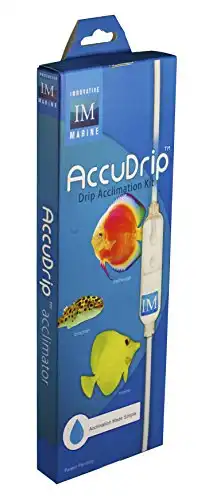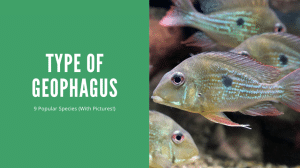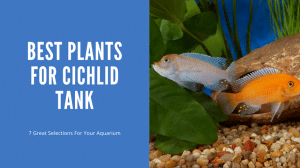Thank you for visiting! By the way… any links on this page that lead to products on Amazon and other stores/partners are affiliate links Aquarium Store Depot earns a commission if you make a purchase.
If you own a reef tank, chances are you have seen cleaner shrimp. These are active and attractive shrimp for your tank. But what do they eat? How often should I feed them? What size tank do they need? These are all questions about cleaner shrimp care that we will answer in this guide to help make caring for these important creatures easier!
A Brief Overview of Cleaner Shrimp
| Scientific Name | Lysmata amboinensis |
| Common Names | Cleaner shrimp, skunk cleaner shrimp, scarlet skunk cleaner shrimp, red skunk cleaner shrimp, and Pacific cleaner shrimp |
| Family | Hippolytidae |
| Origin | Indo-Pacific and the Red Sea |
| Diet | Omnivore |
| Care Level | Easy |
| Temperaturement | Peaceful |
| Minimum Tank Size | 10 Gallons |
| Max Size | 2 – 3 inches with very long antennae |
| Temperature Range | 76 – 82 degrees F |
| pH Range | 8.0 – 8.4 |
| Salinity | 1.025 or 35 PPT |
| Reef Safe | Yes |
| Available As Tank Bred | Rare |
| Filtration/Water Flow | Low |
| Water Type | Saltwater |
| Breeding | Egg-layer |
| Difficulty to Breed | Difficult to breed |
| Compatibility | Species-only tank or community tank |
Origins And Habitat
As one of their common names suggests, the Pacific cleaner shrimp can be found throughout the Pacific Ocean, more specifically in the Indo-Pacific around Indonesia and Australia. Some populations have also been observed in the Red Sea and have some variation in appearance.
There, these invertebrates play an important role in shallow reef ecosystems. They can be found hiding in the cracks and crevices of the rockwork all the way from 16 to 131 feet in depth. As we’ll discuss more later, these saltwater shrimp set up cleaning stations where fish knowingly travel to get cleaned1.
Interestingly, cleaner shrimp are born as males but transition into hermaphrodites as they mature. This is known as protandric simultaneous hermaphroditism and is unique to the Lysmata genus as well as a few other decapods.
On the reef, cleaner shrimp will commonly be seen in pairs but are relatively solitary creatures. They will also form pairs in the aquarium and breeding them is relatively straightforward. However, raising the fry after the eggs hatch is incredibly difficult. This makes coming across tank-raised cleaner shrimp very rare or even nonexistent.
Why Are They Called So?
Cleaner shrimp are very aptly named after their mutualistic relationship with fish. These invertebrates set up service stations on the reef where they wait for both predatory and nonpredatory fish to swim by to be cleaned. As the fish floats near the rock, the shrimp picks at the sides and gills of the fish–sometimes even venturing inside the mouth–to clean parasites, dead tissue, mucus, and other microorganisms.
In both the wild and in the reef aquarium, these shrimp have a unique habit of rocking their legs side to side. Studies have found that this behavior increases when predatory fish are present, possibly signaling their beneficial intentions and asking them to not be eaten.
This study also shows that shrimp are much less likely to clean when in the presence of predatory species and unideal cleaning conditions than when servicing nonpredatory fish in a comfortable environment.
Cleaners vs. Fires

When talking about cleaner shrimp, in general, hobbyists are referring to Lysmata amboinensis. However, fire shrimp (Lysmata debelius), also known as blood shrimp and scarlet cleaner shrimp (pictured above), are also considered as a type of cleaner shrimp.
In comparison, fire shrimp are often a lot less reliable at cleaning than true cleaner shrimp. These bright red invertebrates are great at bringing color to the home aquarium, but they fail to set up true cleaning stations and often stay hidden in the rockwork instead. On top of that, many hobbyists have experienced their fire shrimp going after and killing less active invertebrates, including cleaner shrimp.
There are some benefits to having a fire shrimp, though. For one, their intense color is unparalleled. Though they might stay hidden a better majority of the time, their bright red coloration does not go missed.
In addition, they have been known to eat small pest anemones, like Aiptasia. However, if you’re dealing with an extensive Aiptasia problem, then there are much better shrimp options to choose from, like peppermint shrimp (Lysmata wurdemanni), which form hunting groups that specifically prey on those anemones.
Though you may get lucky and have an especially Aiptasia-hungry fire shrimp!
What Do They Look Like?

Cleaner shrimp are a very simple-looking, yet appealing shrimp species. All cleaner shrimp will look the same, with red, white, and yellow coloration. There have been some observed variations between those collected from the Red Sea and Indo-Pacific individuals, but the difference is minimal.
Cleaner shrimp are also known as scarlet skunk cleaner shrimp due to their colors. They have two brilliant red lines along their back with dark yellow legs. Against those red lines, they have a long white stripe reaching from the antennae to the top of the head and all the way to the telson (tail). On the tail itself, there are multiple white spots.
This white line greatly resembles the signature patterns of a skunk, earning the skunk cleaner shrimp its name!
As a decapod, cleaner shrimp have ten legs. Cleaner shrimp also have small pincers that help them pick off foreign objects from fish as well as any microorganisms that might be living in the crevices of the rockwork.
Tank Requirements
Cleaner shrimp do not need much to thrive, though they may sometimes die for apparently no reason at all. On average, they only live for a few years.
These shrimp are one of the larger shrimp species available in the saltwater aquarium, but one can still comfortably be kept in a 10 gallon aquarium; some hobbyists have kept them in 5 gallons, but those pico tanks should be kept for other smaller and more ornate species, like pistol shrimp (Alpheidae family).
While cleaner shrimp won’t explore all a reef tank has to offer, they can be very active within their own given territory. These shrimp set up stations for fish to get cleaned, often at the top or side of the rockwork. They’ll usually use these rocks as areas to sleep and to hide while molting as well. There, they will scavenge for food in and around the rocks and accommodate any fish that want to be cleaned.
Cleaner shrimp do not require any special water parameters. However, like other invertebrates, they are extremely sensitive to traces of copper in the water as well as high nitrates. Contrary to popular belief though, invertebrates do need some traces of copper present in the water for healthy shell growth. Large amounts, like those found in some aquarium medications, will be deadly.
Otherwise, cleaner shrimp are generally hardy and can withstand some minor deviations from ideal water conditions.
Acclimation
Perhaps even more important than correct water conditions is giving ample time to slowly acclimate your new shrimp to your tank. Though hardy once established, this shrimp species can be very sensitive to large and sudden changes in water parameters.
There are a few methods to guarantee that the transition from store to home aquarium is as safe as can be for your new cleaner shrimp:
- Bring a cooler or insulated bag to carry home the shrimp from the store. This will keep your cleaner shrimp in the dark while preventing drastic water temperature fluctuations and ultimately reducing stress.
- Once at home, turn off the aquarium light and float the bag in the aquarium for about 15-20 minutes. This will give time for temperatures to match between the store water and the display water.
- For almost all invertebrates, it is best to drip acclimate. Empty the store water and shrimp into a bucket and attach a drip acclimator. If you do not have one available, simply tie a loose knot in a piece of airline tubing to slow the flow.
- Allow the water volume to double in the bucket. This usually takes about an hour, though you may continue acclimation for up to two hours for extra precaution.
- When enough time has passed, it’s time to transfer the shrimp into the tank. It is best to use your hand or a plastic container as their legs and antennae can get stuck in netting. Your shrimp will likely head straight to the back of the tank and find coverage under a rock. Over the next few days, your cleaner will start to return to normal and set up a cleaning station somewhere in the tank.
Most of us know that fish and shrimp are sensitive creatures, who don't do well with sudden changes. The Accudrip Acclimator is here to help adjust your aquatic creatures to new tanks and conditions
If your shrimp does happen to lose a leg or antennae during the process, don’t worry. Shrimp have the incredible ability to rejuvenate lost limbs when they molt. Though this is not ideal, they should be okay as long as water conditions are favorable!
Temperament
Many beginner hobbyists see cleaner shrimp and see other shrimp, like fire shrimp, and think that the two species will get along in the same tank. Though cleaner shrimp are very peaceful, they can actually be a little temperamental towards other related species.
As mentioned before, cleaner shrimp set up very distinct territories. If another shrimp were to accidentally enter this territory, the cleaner shrimp would be very capable of defending itself. For this reason and for controlling bioload, multiple species of marine shrimp are not typically kept together unless it is a larger system.
Molting
As a crustacean, cleaner shrimp go through the molting process. This is when the shrimp sheds its exoskeleton in order to grow. This happens about every month or two and can make you believe that your shrimp is dead!
When cleaner shrimp molt, they shed their exoskeleton in one complete piece. This empty shell looks exactly like the shrimp only lifeless, which leads many hobbyists to believe that the molt is actually a carcass. During this time, your shrimp is at its most vulnerable and will usually be hiding in the back of the tank.
Make sure that your shrimp reappears after a few hours. Leave the molt in the tank as the shrimp will eat it and regain some calcium as well as other important nutrients. If you don’t see your shrimp after a few hours and you notice that bristle worms and other scavengers are starting to circle around it, then this might actually be your dead shrimp.
Are They Reef Safe?
Yes, cleaner shrimp are almost always reef safe; of course, there is always that rogue shrimp that will go off and consume a whole colony of zoanthids overnight. Generally, there is no cause for concern.
The biggest concern with cleaner shrimp, though, is them swimming over and irritating corals. If your shrimp decides to set up its territory right next to a sensitive coral, then it could cause some indirect irritation. This is usually nothing to worry about though, and the coral should adapt over time.
Tankmates
In addition to being reef safe, these shrimp can also be kept with an assortment of tankmates. They do best in community saltwater settings with wrasses, clownfish, and tangs. Cleaner shrimp will even do well with fish that aren’t reef safe like, butterflyfish and small angelfish.
As we mentioned earlier, though, they do service predators in the wild so those aren’t completely off the table either. Check out the video below by NatureFootage of a cleaner shrimp working on a Moray Eel!
What Fish Eat Them?
Many saltwater aquarium fish will gladly take the opportunity to munch on a shrimp. This includes obvious predators, like triggers, groupers, and puffers, though larger angels and wrasses might even try to nip at them.
As cleaner fish have gotten more expensive over the past few years in the aquarium hobby, it’s usually not recommended to try keeping them with larger, more aggressive species. However, some hobbyists intentionally introduce cleaner shrimp into their tanks as a live food option. Not only do cleaner shrimp naturally increase predatory instincts, but their hard chitin shells help keep beaks and teeth trimmed.
It is also important to note that on rare occasions, sea anemones have been known to catch and digest cleaner shrimp that may walk over their mouths.
What Do They Eat?
Cleaner shrimp are omnivores. While they get a lot of their required diet from picking parasites off of fish, this is not enough to sustain them. Luckily, they are not particularly picky about what they eat otherwise.
For the most part, cleaner shrimp will gladly eat any pellet or flake foods that are added to the tank. They will even help dispose of any fish or invertebrates that might have died and gotten stuck under a rock or in the back of the tank.
One thing cleaner shrimp won’t do though is treat an algae problem. Cleaner shrimp are sometimes lumped together with other cleanup crew members. While they are opportunistic feeders and largely scavengers, they won’t help contain algae or clean up fish waste. In fact, they’ll usually avoid setting up stations in algae-covered areas.
Can They Treat Ich?
Parasites contribute to cleaner shrimp diet to an extent. Though these invertebrates will definitely eat ich (cryptocaryon irritans) off of the sides and gills of fish, they shouldn’t be entirely depended on to treat the whole reef tank for an infestation.
In short, there are simply way too many parasites to control by one shrimp. The cryptocaryon irritans life cycle is also pretty complex and shrimp won’t eat them at all stages, leaving them to reproduce freely and replace those that have already been eaten.
This goes for other parasitic infestations as well, like marine velvet (Oodinium spp.); cleaner shrimp will eat those parasites, by they will by no means serve as a full treatment for those parasites.
Final Thoughts
If you’re looking for something to fill your tank up with something other than a fish, then a cleaner shrimp is definitely something to consider. Though they’ve become reasonably more expensive over the past few years, their fascinating cleaning mutualism with fish is a behavior that can’t be seen with other invertebrates.
Keep in mind that these shrimp carry the bioload of a small fish and should not be considered a member of the cleanup crew. Otherwise, they are very forgiving of small fluctuations in water parameters as long as they are acclimated correctly!
- About the Author
- Latest Posts
I’m thrilled that you found Aquarium Store Depot! Here you’ll find information on fish, aquariums, and all things aquatics related. I’m a hobbyist (being doing this since I was 11) and here to help other hobbyists thrive with their aquariums! I adhere to a high quality Editorial Process and Review products with real life field usage and practical analysis.







Thanks ken just got 3 got 3 clowns